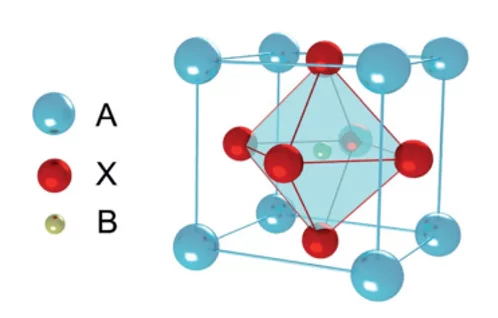The growing demand for new compounds with excellent optoelectronic properties has motivated a strong scientific interest in developing and tailoring novel perovskites. Their unique physical properties make perovskites promising and appealing candidates for technological applications such as solar cells, LEDs, lasers, photodetector devices, etc...
Perovskites can be described by the general formula ABX3 (see picture), where:
- A is a monovalent cation (e.g., Cs+, MA+, FA+,…, with MA= methylammonium, FA=formamidinium);
- B is a divalent metal cation (e.g., Sn2+, Pb2+);
- X is a halide anion (e.g., Cl-, Br-, or I-).
In three articles published in 2021 (Dhanabalan et al., 2021; Cinquino et al., 2021; Polimeno et al., 2021), researchers from Italy and Switzerland used the macromolecular crystallography beamline X06DA-PXIII at the Swiss Light Source (Switzerland), as well as BL-5A at the Photon Factory (Japan) to characterize hybrid organic-inorganic perovskites, for which the A cation is organic and the packing consists of alternating layers of organic and inorganic corner-sharing BX6 octahedra layers. The great and fascinating potential of these hybrid materials relies on the large tunability of their optoelectronic properties: e.g., by changing the kind of organic molecules or the thickness of the inorganic slabs (i.e., the number n of the inorganic layers in the slabs) strong differences in the wavelength of the emission occur.
To suitably engineer the optoelectronic properties of hybrid organic-inorganic perovskites, synchrotron radiation was instrumental (1) to identify and improve new crystalline materials, (2) to characterize the crystal packing, to identify the structure-property relationships, and consequently, to reveal the amazing optoelectronic properties of those new compounds.
Single crystals of perovskites can be laminar samples of a few micron thick (as for our cases of study) with imbricate structures, which prevent the successful characterization using conventional laboratory X-ray sources. Here, small crystals down to a few tens of microns, combined with synchrotron beam turned out essential for successful structure solution and refinement of those new hybrid perovskites. In Dhanabalan et al., 2021, the collaboration with the Instituto Italiano di Tecnologia (IIT) of Genova, Italy, lead to the structural characterization of the hybrid perovskite (N-MDDA)2PbBr4, whose organic cation is an amine, revealing the presence of H-bonds responsible of the distortion of the inorganic chains and allowing to estimate the distortion degree of the chains. The collaboration with the Institute NANOTEC of the CNR of Lecce, Italy, yielded the crystal structure of the following 2 perovskites: (1) a new 2D hybrid organic-inorganic perovskite F(C6H5(CH2)2NH3)2PbI4 (Polimeno et al., 2021) featuring unique optical birefringence, as well as (2) two new 2D hybrid organic-inorganic perovskites (Cinquino et al., 2021), with a number of inorganic layers n > 1. The study proved the efficiency of a new synthesis protocol applied for preparing the compounds (C12)2(MA)n-1PbnI3n+1 (where C12= C12H25NH3+), and determining the degree of distortion of the inorganic layers.
These works highlight the benefit of synchrotron radiation to characterize challenging crystalline perovskites crystals and open the door to further exploring the amazing world of perovskites.
Contact
Publications
Balaj Dhanabalan, Giulia Biffi, Anna Moliterni, Vincent Olieric, Cinzia Giannini, Gabriele Saleh, Louis Ponet, Mirko Prato, Muhammad Imran, Liberato Manna, Roman Krahne, Sergey Artyukhin, Milena P. Arciniegas, ’Engineering the optical Emission and Robustness of Metal-Halide Layered Perovskites through Ligand Accommodation’, (2021). Adv. Mater. 33, 2008004.
https://doi.org/10.1002/adma.202008004
Marco Cinquino, Antonio Fieramosca, Rosanna Mastria, Laura Polimeno, Anna Moliterni, Vincent Olieric, Naohiro Matsugaki, Riccardo Panico, Milena De Giorgi, Giuseppe Gigli, Cinzia Giannini, Aurora Rizzo, Daniele Sanvitto, Luisa De Marco, ’Managing Growth And Dimensionality of Quasi 2D Perovskite Single-Crystalline Flakes For Tunable Excitons Orientation’, (2021). Adv. Mater. 33, 2102326.
https://doi.org/10.1002/adma.202102326
Laura Polimeno, Giovanni Lerario, Milena De Giorgi, Luisa De Marco, Lorenzo Dominici, Francesco Todisco, Annalisa Coriolano, Vincenzo Ardizzone, Marco Pugliese, Carmela T. Prontera, Vincenzo Maiorano, Anna Moliterni, Cinzia Giannini, Vincent Olieric, Giuseppe Gigli, Dario Ballarini, Qihua Xiong, Antonio Fieramosca, Dmitry D. Solnyshkov, Guillaume Malpuech, Daniele Sanvitto, ’Tuning of the Berry curvature in 2D perovskite polaritons’, (2021). Nat. Nanotechnol. 16, 1349-1354.
https://doi.org/10.1038/s41565-021-00977-2
